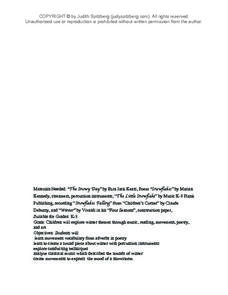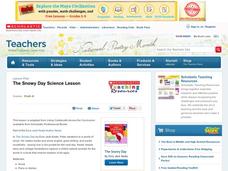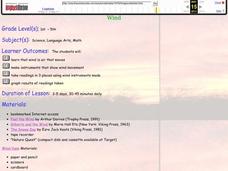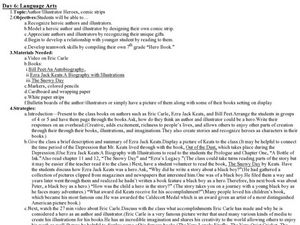Education World
Every Day Edit - Ezra Jack Keats
For this everyday editing learning exercise, learners correct grammatical errors in a short paragraph about Ezra Jack Keats. The errors range from punctuation, capitalization, grammar, and spelling.
Lakeshore Learning
Fun in the Snow
Celebrate the arrival of winter with a reading of Jack Ezra Keats' book The Snowy Day. Engaging children by asking them about their own experiences in the snow, the teacher goes on to read the story aloud before asking the class to draw...
PBS
Reading Adventure Pack: The Snowy Day
Scholars listen to a read-aloud of fiction and nonfiction books, The Snowy Day, written and illustrated by Ezra Jack Keats, and Snow Is Falling, written by Franklyn Branley and illustrated by Holly Keller, then take part in four creative...
Curated OER
Winter Through the Arts
Students read the book The Snowy Day and discover various winter themes. In this winter lesson, students develop movements to express the feeling of a snowstorm. Students also construct winter-themed art pieces.
Curated OER
The Snowy Day Science Lesson
Students listen to the story The Snowy Day by Ezra Jack Keats in order to become interested in the world of snow. In this snow exploration lesson, students scoop up snow to make snowballs, measuring the amount of snow they use so each...
Akron Art Museum
Storytelling Resist
The illustrations of Ezra Jack Keats in The Snowy Day inspire young artists to examine shapes in illustrations and to use these shapes to create their own watercolor resist painting.
Curated OER
Snowy Days
Students explore the book "The Snowy Day" by Ezra Jack Keats. They predict what the story is about and predict what will happen in the story. Students write their own endings for the story.
Curated OER
Snowflakes
Students read "The Snowy Day," by Ezra Jack Keats and construct snowflakes to decorate the classroom walls. They examine how snowflakes are formed and study new vocabulary words.
Curated OER
Winter Clothing
After listening to a reading of The Snowy Day, by Era Jack Keats, language learners use a SMART board and drag the appropriate vocabulary word to the correct clothing article. They then record and illustrate the new vocabulary words in...
Curated OER
Winter vs. Summer
Students explore the seasons. In this winter and summer lesson, students read The Snowy Day by Ezra Jack Keats and Summer by Maria Ruis. Students compare the 2 seasons as they create t-charts, try on seasonal clothing, and create collages.
Curated OER
And Tomorrow's Forecast Is...
Students create original short stories that feature distinctive weather phenomena, such as rainbows, snowstorms, tornadoes, thunder and/or lightning. They use a story map, imbedded in this plane, to help them organize their story.
Curated OER
Weather Walks
Students study weather by taking walks in various types weather conditions.
Curated OER
Wind
Students make a wind vane, anemometer, wind spiral, and wind streamer to calculate wind movement. In this wind lesson plan, students test each of their wind instruments, and graph the results of the wind speed in different locations.
Curated OER
Author/Illustrator Heroes
Middle schoolers recognize heroic authors and illustrators and create their own comic strips. In this language arts lesson, students examine characteristics of heroes and work in groups to create their own comic strips and hero books.
Curated OER
Sentence Structure Subject Noun Worksheet
In this nouns learning exercise, students use the nouns from the list to complete the chart. Students write the words into person, place, or thing chart sections.
















